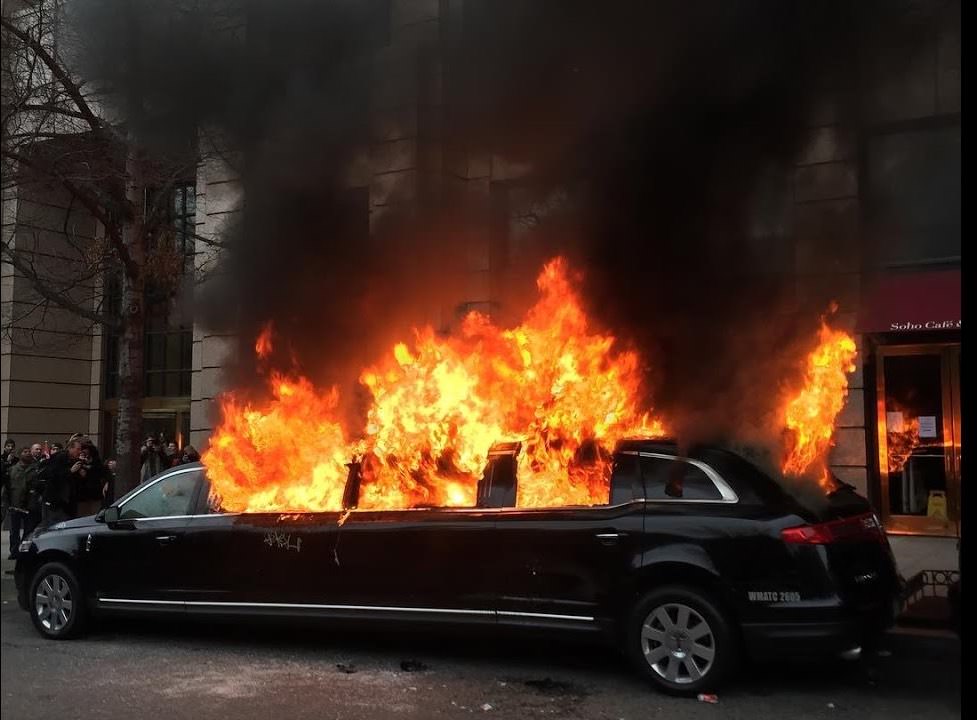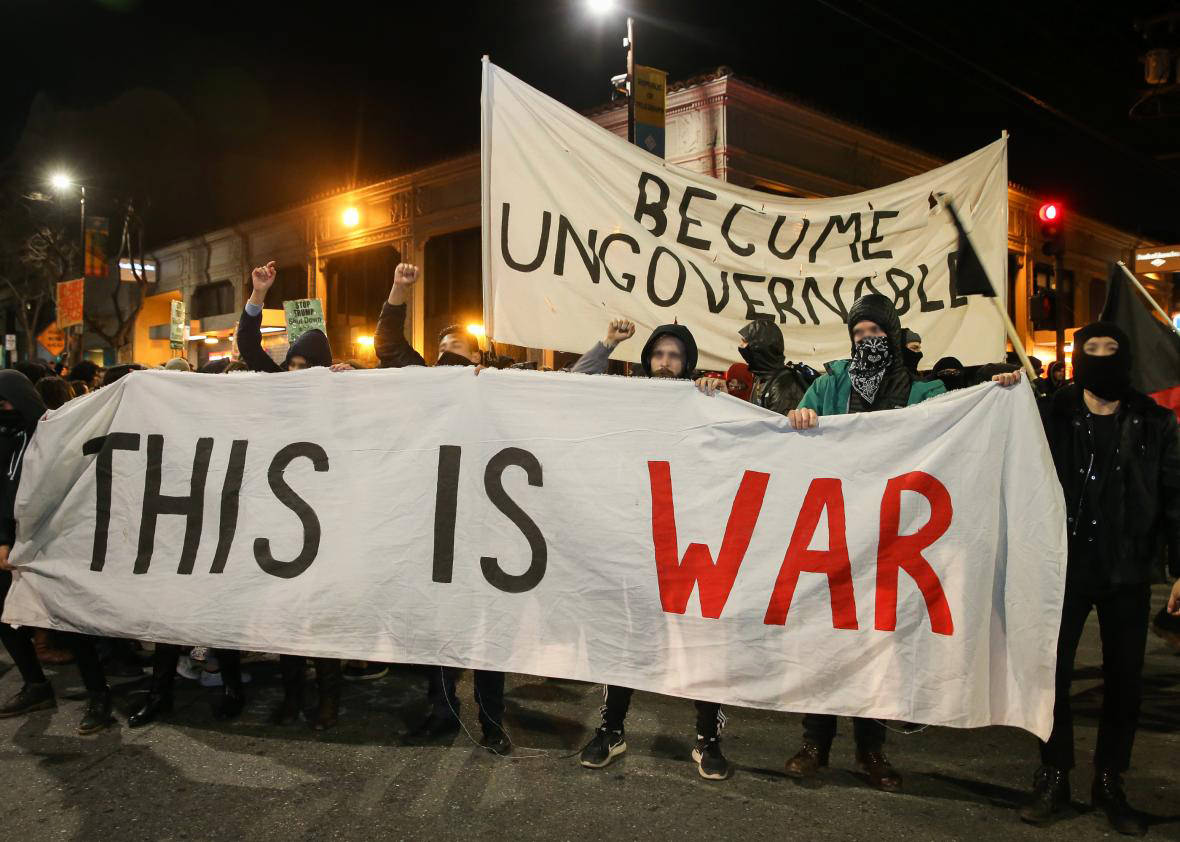
We’ve reached the first plateau of the Trump era. Round one is over and we’re still in the fight. With so much happening so fast, it can be hard to step back and get enough perspective to keep ahead of events. Let’s review the events of the past month and get a sense of where we are, so we can strategize for what comes next.
Phase One: Escalation in the Streets
The Trump era began with blockades and confrontational demonstrations in Washington, DC and around the country. Footage of white nationalist Richard Spencer being punched by a person in black bloc attire made antifascists popular even with television stars, though the shooting of a Seattle antifascist by a supporter of Milo Yiannopoulos ended the day on an ominous note. The Women’s March the next day saw some of the biggest crowds in protest history.
Here, at the outset, we encounter the fundamental tension between quality and quantity that has marked all resistance to Trump. On the one side, we see fierce and courageous rebels who are not numerous enough to avoid being isolated and repressed; on the other, we see truly massive numbers of people limited by their narrow tactical repertoire and naïve faith in existing institutions. Everyone invested in real social change should recognize how important it is for these two social bodies to cross-pollinate.

Even Portland, OR was uncontrollable on the night of the presidential election.

Washington, DC celebrated the inauguration in style.
Unfazed by this one-two punch, Trump presented a string of executive orders aimed at forcing through the Dakota Access Pipeline, stepping up deportations, and banning people from seven countries—essentially declaring war on the part of the US population that opposed his Presidency. This was a make-or-break moment, and people rose to it, shutting down airports around the country the weekend of January 28-29. These blockades were complemented by a taxi strike and demonstrations in several major cities.
“We will repel bullies. We will shelter freaks and outcasts; those who have no home. We will get past the lies. We will hunt monsters… And when we are lost amidst the hypocrisy and casual violence of certain individuals and institutions… we will… punch some people in the face when they seek to destroy the weak and the disenfranchised and the marginalized. And we will do it all with soul, with heart, and with joy.” -David K. Harbour
Three days later, courageous demonstrators shut down Milo’s speaking event at the University of California at Berkeley. Anarchists saw this as a victory for direct action, while liberals wrung their hands and Milo’s fans congratulated themselves that the “tolerant left” were falling into a trap, discrediting themselves. Trump himself took notice with a series of tweets about “professional anarchists” and “violence,” while the New York Times dedicated a front-page article to the spread of anarchist anti-fascism.
In this context of escalation, the stakes are double or nothing: either direct action tactics will spread to the population at large, enabling all the different demographics targeted by the government to defend themselves, or they will remain confined to a small minority that the authorities can use as an excuse to crack down on everyone. Standing aside “peacefully” in hopes of being left alone is no longer an option.
Phase Two: Fractures in the Halls of Power
After these first two tempestuous weeks, concluding with the Bodega strike of February 2, the pace and scale of street protests subsided a bit as the spotlight shifted to the halls of power—where real fractures within the ruling class were appearing. February has seen much of the corporate media turn decisively against the Trump administration, evidence of rebellion within the White House, turmoil on the National Security Council as Michael Flynn was forced to resign in disgrace and Trump’s first choice to replace him refused the job, and the definitive judicial defeat of the first version of the Muslim Ban.
Doubtless, much of this was galvanized by the grassroots resistance of the first two weeks. By showing that the US will be ungovernable under Trump, demonstrators made it impossible for bureaucrats and pundits to line up behind the President for the sake of preserving order.
These divisions now extend all the way into Trump’s party. Milo’s sordid demise on February 20-21 illustrates this adequately enough. The Republican Party that swept into power behind Trump was based on a tenuous alliance between traditional conservatives and a new generation of nationalistic racists like Milo. Milo sold himself to white nationalists and authoritarians on the basis of his status as a (barely) oppressed person willing to speak in favor of oppression; like so many others who have struck that Faustian deal, he learned the hard way that he was not the one calling the shots. While he is implicated in his own downfall, it was anarchists who forced the issue, compelling Trump and the Conservative Political Action Conference to embrace and then repudiate him.
Without spokespeople like Milo, the Republican Party will lose everything that gave it a modern edge. And although Milo and other stooges of Steve Bannon doubtless hope that their explicitly racist nationalism will be the successor to Trump’s populism, allegations of promoting pedophilia do not make a good point of departure for a new far-right party.

Crowds shut down Seatac on January 28 and 29 in response to Trump’s immigration ban.

Protestors declare war on Milo at UC Berkeley on February 1.
Phase Three: The Empire Strikes Back?
In short, a burst of grassroots resistance at the opening of Trump’s term has helped to discredit his Presidency and split his support base. This is the context in which Trump and his cronies are seeking to take his message back to the streets, starting with the rally in Florida and hoping to continue with events around the country on March 4. They desperately need to mobilize street-level support in order to rally Republican politicians to remain loyal to them and to build the grassroots momentum necessary to implement their fascistic agenda.
Although the resistance has made a good showing thus far, it is still entirely possible that Trump and his cronies will succeed in pulling off their plan. Escalating ICE raids around the country attest to the danger threatening millions. As this goes to press, Standing Rock is being evicted, showing that apparent victories under Obama were really just temporary compromises. The following months will be decisive in determining whether Trump can consolidate power behind a new form of fascism, or whether ungovernable social movements will make this impossible.
In this situation, there are three basic errors we should avoid.
We must not become immobilized watching the spectacle of resistance to Trump as it plays out in the courts and Washington, DC. The strength of the institutional pushback against Trump is a direct factor of grassroots mobilization and resistance. If Trump is removed from office by institutional means, he will only be replaced by a politician who will likely implement versions of the same agenda—just as Obama already escalated deportation and surveillance. Even if he fails to establish autocracy in the United States, Trump’s role will be to reestablish the legitimacy of the corporate media, moderate Republicans, Silicon Valley, and the Democratic Party—all the adversaries we were fighting before he made them seem ethical by comparison. For now, some Democrats and media outlets appear sympathetic to us, but their standard strategy in a situation like this is to use us as shock troops to obtain a little leverage over the authorities, then sell us out in return for a seat at the table.
We must not make the same error as Milo, mistaking media exposure for power. Notoriety can help us when it enables us to make contact with new people or to spread our ideas and tactics in meaningful ways. But if we receive too much media coverage, more quickly than we can translate it into added organizational strength on the ground, it will only position the authorities to go after us with everything they’ve got. Remember the lesson of the SHAC campaign, which seemed to be making tremendous headway against an animal testing corporation by building up a fearsome reputation—until the government took advantage of this reputation to stomp it out. There are no shortcuts to doing the work of grassroots organizing, certainly not through corporate media.
We probably won’t be able to avoid open conflict with Trump’s civilian supporters, but we should not let it distract us from taking on the government directly. If the Trump administration fails to fulfill its promises, many of those who currently support it may reconsider their position—the last thing we want to do is force them to entrench themselves in their current position. We have to find ways to take the offensive against the authorities while defending ourselves against rearguard attacks from freelance nationalists.
Above all, we need to pass on all the knowledge we have accumulated over the past two decades of anarchist activity to a new generation of demonstrators—and quick. We are but a small part of the huge social body that is prepared to enter into struggle now, but that struggle may never get off the ground unless we share what we know with others. Never before have so many people been open to anarchist ideas and tactics, but this window will not last long. Expanding our ranks is the only way to survive the waves of repression that wait ahead. Let’s go into round two with more numbers and more strength.
Further Reading
The Landing: Fascists without Fascism





